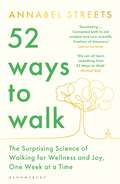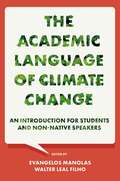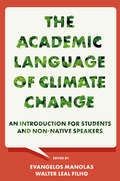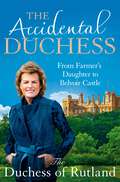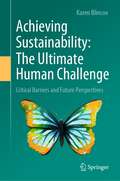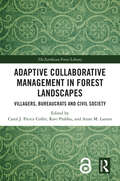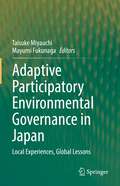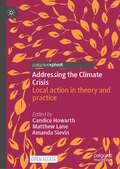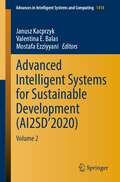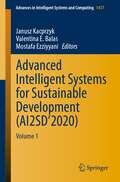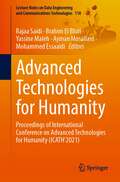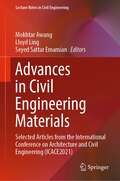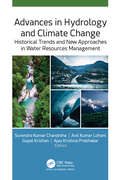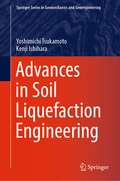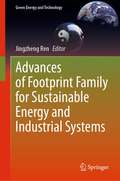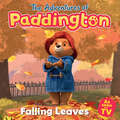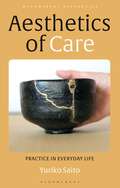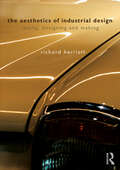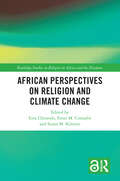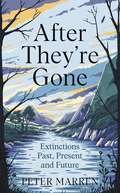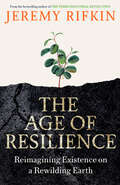- Table View
- List View
52 Ways to Walk: The Surprising Science of Walking for Wellness and Joy, One Week at a Time
by Annabel Streets_________________________________'A delightful balance of ideas, inspiration and science' Tristan Gooley, author of The Walker's Guide to Outdoor Clues & Signs_________________________________“Walking had become, once again, the great adventure of my life. But this time science could explain how and why” Walking strengthens our bodies, calms our minds and lifts our spirits. But it does so much more than this. Our vision, hearing, respiration, sleep, cognition, memory, blood pressure, sense of smell and balance (to name a few) are all enhanced by how we walk. For instance: · Walking in cold weather burns extra fat and builds more muscle.· Walking alone strengthens our memories.· Walking in woodland helps us sleep.· And there's nothing more restorative than a romantic nighthike.Our choice of location, time, direction, duration, walking companion and gait, as well as the weather we opt to walk in, can transform our daily stroll. Here, Annabel Streets shares the thrill of 52 walking styles, explaining the latest science behind each one, and providing practical tips for making the most of your daily steps.52 Ways to Walk is a revelatory and informative handbook for anyone stuck in a walking rut, curious about the lesser-known benefits of walking or merely in need of some on-foot novelty and adventure. _________________________________Beautifully designed and pocket-sized, 52 Ways to Walk is a love letter to walking.
The Academic Language of Climate Change: An Introduction for Students and Non-native Speakers
by Evangelos Manolas Walter Leal FilhoClimate change is one of the greatest challenges of our time. For the sake of human civilization and life on earth we must do all we can to keep global warming at the lowest possible level. Addressing climate change is everyone’s duty and that includes teachers of English. In order to support students and non-native English speakers, this important work provides an introduction to climate change via simple chapters addressing different and important dimensions of climate change and helps students acquire basic language skills which will allow them to study similar or more difficult texts. Each chapter offers an introduction on the topic discussed and its relation to climate change, outlines climate change or other related environmental science terms and 6-8 exercises on grammar, syntax and consolidation of terminology. Topics covered include climate change and tourism, gender, worker safety, mental and physical health, food production, deforestation, art, and much more. Offering an interdisciplinary introduction to climate change and its intersection with numerous industries and facets of life, The Academic Language of Climate Change, provides a necessary and welcome introduction for undergraduate and graduate students, and any non-native English speakers seeking to engage with climate change research.
The Academic Language of Climate Change: An Introduction for Students and Non-native Speakers
by Evangelos Manolas, Walter Leal FilhoClimate change is one of the greatest challenges of our time. For the sake of human civilization and life on earth we must do all we can to keep global warming at the lowest possible level. Addressing climate change is everyone’s duty and that includes teachers of English. In order to support students and non-native English speakers, this important work provides an introduction to climate change via simple chapters addressing different and important dimensions of climate change and helps students acquire basic language skills which will allow them to study similar or more difficult texts. Each chapter offers an introduction on the topic discussed and its relation to climate change, outlines climate change or other related environmental science terms and 6-8 exercises on grammar, syntax and consolidation of terminology. Topics covered include climate change and tourism, gender, worker safety, mental and physical health, food production, deforestation, art, and much more. Offering an interdisciplinary introduction to climate change and its intersection with numerous industries and facets of life, The Academic Language of Climate Change, provides a necessary and welcome introduction for undergraduate and graduate students, and any non-native English speakers seeking to engage with climate change research.
The Accidental Duchess: From Farmer's Daughter to Belvoir Castle
by Emma Manners, RutlandLife in a castle isn’t always a fairytale, as the Duchess of Rutland vividly illustrates in her fascinating, revealing and funny autobiography.When Emma Watkins, the pony-mad daughter of a Welsh farmer, imagined her future it was as the wife of a younger version of her father. But then she fell in love with David Manners, having no idea that he was heir to one of the most senior hereditary titles in the land. When David succeeded his father, against all the odds Emma became the chatelaine of Belvoir Castle, ancestral home of the Dukes of Rutland.She had to cope with five boisterous children while faced with a vast estate in desperate need of modernisation and staff who wanted nothing to change - it was a daunting responsibility. Yet with sound advice from the doyenne of duchesses, ‘Debo’ Devonshire, she met each challenge with optimism and gusto, including scaling the castle roof in a storm to unclog a flooding gutter; being caught in her nightdress by mesmerised Texan tourists; and disguising herself as a cleaner to watch filming of The Crown. She even took on the castle ghosts . . . At times the problems she faced seemed insoluble, yet with her unstoppable energy and talent for thinking on the hoof, she won through, inspired by the vision and passion of those Rutland duchesses in whose footsteps she trod, and indeed the redoubtable and resourceful women who forged her, whose homes were not castles but remote farmhouses in the Radnorshire hills.Vividly written and bursting with insights, The Accidental Duchess will appeal to everyone who has visited a stately home and wondered what it would be like to live there.
Achieving Sustainability: Critical Barriers and Future Perspectives
by Karen BlincoeThe book provides an assessment of whether sustainability is realizable in the current societal framework. What are the challenges and the barriers - and what are the levers necessary to meet and overcome them?Through a revision of the essence of sustainability the book provides an opportunity to understand the deeper level of the radical change that sustainability represents, and the resistance that is preventing its realization.To build the argument the sustainable development model is compared with current development theories as well as alternative solutions based on utopian models of the past. The book assesses the results that can be achieved within the current systemic framework, based on case stories. It outlines the limitations to sustainability, pointing out and defining the multiple, cross-sectoral and systemic barriers that hinder the transition.Finally, the book offers perspectives on achieving a sustainable future, encompassing the impacts from recent events including the pandemic as well as the multiple mitigation and transition initiatives undertaken globally.Brian Goodwin's QuoteLike the caterpillar that wraps itself up in its silken swaddling bands prior to its metamorphosis into a butterfly, we have wrapped ourselves in a tangled skin from which we can emerge only by going through a similarly dramatic transformation.
Adaptive Collaborative Management in Forest Landscapes: Villagers, Bureaucrats and Civil Society (The Earthscan Forest Library)
by Carol J. Pierce Colfer Ravi Prabhu Anne M. LarsonThis book examines the value of Adaptive Collaborative Management for facilitating learning and collaboration with local communities and beyond, utilising detailed studies of forest landscapes and communities. Many forest management proposals are based on top-down strategies, such as the Million Tree Initiatives, Forest Landscape Restoration (FLR) and REDD+, often neglecting local communities. In the context of the climate crisis, it is imperative that local peoples and communities are an integral part of all decisions relating to resource management. Rather than being seen as beneficiaries or people to be safeguarded, they should be seen as full partners, and Adaptive Collaborative Management is an approach which priorities the rights and roles of communities alongside the need to address the environmental crisis. The volume presents detailed case studies and real life examples from across the globe, promoting and prioritizing the voices of women and scholars and practitioners from the Global South who are often under-represented. Providing concrete examples of ways that a bottom-up approach can function to enhance development sustainably, via its practitioners and far beyond the locale in which they initially worked, this volume demonstrates the lasting utility of approaches like Adaptive Collaborative Management that emphasize local control, inclusiveness and local creativity in management. This book will be of great interest to students, scholars and practitioners working in the fields of conservation, forest management, community development and natural resource management and development studies more broadly.
Adaptive Collaborative Management in Forest Landscapes: Villagers, Bureaucrats and Civil Society (The Earthscan Forest Library)
by Carol J. Pierce Colfer, Ravi Prabhu, and Anne M. LarsonThis book examines the value of Adaptive Collaborative Management for facilitating learning and collaboration with local communities and beyond, utilising detailed studies of forest landscapes and communities. Many forest management proposals are based on top-down strategies, such as the Million Tree Initiatives, Forest Landscape Restoration (FLR) and REDD+, often neglecting local communities. In the context of the climate crisis, it is imperative that local peoples and communities are an integral part of all decisions relating to resource management. Rather than being seen as beneficiaries or people to be safeguarded, they should be seen as full partners, and Adaptive Collaborative Management is an approach which priorities the rights and roles of communities alongside the need to address the environmental crisis. The volume presents detailed case studies and real life examples from across the globe, promoting and prioritizing the voices of women and scholars and practitioners from the Global South who are often under-represented. Providing concrete examples of ways that a bottom-up approach can function to enhance development sustainably, via its practitioners and far beyond the locale in which they initially worked, this volume demonstrates the lasting utility of approaches like Adaptive Collaborative Management that emphasize local control, inclusiveness and local creativity in management. This book will be of great interest to students, scholars and practitioners working in the fields of conservation, forest management, community development and natural resource management and development studies more broadly.
Adaptive Participatory Environmental Governance in Japan: Local Experiences, Global Lessons
by Taisuke Miyauchi Mayumi FukunagaThis book contributes to the theoretical and practitioner literature in environmental governance and sustainability of natural resources by linking case studies of the roles of narratives to the three key practices in local environmental governance: socio-political legitimacy in participation; collaboratively creating stakeholder-ness, and cultivating social and ecological capabilities. It provides numerous theoretical insights on legitimacy, adaptability, narratives, process-oriented collaborative planning, and among others, using in-depth case studies from historical and contemporary environmental issues including conservation, wildlife management, nuclear and tsunami disasters, and thus community risk, recovery, and resiliency. The authors are all practitioner-oriented scientists and scholars who are involved as local stakeholders in these practices. The chapters highlight their action and participatory-action research that adds deeper insights and analyses to successes, failures, and struggles in how narratives contribute to these three dimensions of effective environmental governance. It also shows how stakeholders’ kinds of expertise, in a historical context, help to bridge expert and citizen legitimacy, as well as spatial and jurisdictional governance structures across scales of socio-political governanceOf particular interest, both within Japan and beyond, the book shares with readers how to design and manage practical governance methods with narratives. The detailed design methods include co-imagination of historical and current SESs, designing processes for collaborative productions of knowledge and perceptions, legitimacy and stakeholder-ness, contextualization of contested experiences among actors, and the creation of evaluation standards of what is effective and effective local environmental governance.The case studies and their findings reflect particular local contexts in Japan, but our experiences of multiple natural disasters, high economic growth and development, pollutions, the nuclear power plant accident, and rapidly aging society provide shared contexts of realities and provisional insights to other societies, especially to Asian societies.
Addressing the Climate Crisis: Local action in theory and practice
by Candice Howarth Matthew Lane Amanda SlevinThis open access book brings together a collection of cutting-edge insights into how action can and is already being taken against climate change at multiple levels of our societies, amidst growing calls for transformative and inclusive climate action. In an era of increasing recognition regarding climate and ecological breakdown, this book offers hope, inspiration and analyses for multi-level climate action, spanning varied communities, places, spaces, agents and disciplines, demonstrating how the energy and dynamism of local scales are a powerful resource in turning the tide. Interconnected yet conceptually distinct, the book’s three sections span multiple levels of analysis, interrogating diverse perspectives and practices inherent to the vivid tapestry of climate action emerging locally, nationally and internationally. Delivered in collaboration with the UK’s ‘Place-Based Climate Action Network’, chapters are drawn from a wide range of authors with varying backgrounds spread across academia, policy and practice.
Advanced Intelligent Systems for Sustainable Development: Volume 2 (Advances in Intelligent Systems and Computing #1418)
by Janusz Kacprzyk Mostafa Ezziyyani Valentina E. BalasThis book publishes the best papers accepted and presented at the 3rd edition of the International Conference on Advanced Intelligent Systems for Sustainable Development Applied to Agriculture, Energy, Health, Environment, Industry, Education, Economy, and Security (AI2SD’2020). This conference is one of the biggest amalgamations of eminent researchers, students, and delegates from both academia and industry where the collaborators have an interactive access to emerging technology and approaches globally. In this book, readers find the latest ideas addressing technological issues relevant to all areas of the social and human sciences for sustainable development. Due to the nature of the conference with its focus on innovative ideas and developments, the book provides the ideal scientific and brings together very high-quality chapters written by eminent researchers from different disciplines, to discover the most recent developments in scientific research.
Advanced Intelligent Systems for Sustainable Development: Volume 1 (Advances in Intelligent Systems and Computing #1417)
by Janusz Kacprzyk Mostafa Ezziyyani Valentina E. BalasThis book publishes the best papers accepted and presented at the 3rd edition of the International Conference on Advanced Intelligent Systems for Sustainable Development Applied to Agriculture, Energy, Health, Environment, Industry, Education, Economy, and Security (AI2SD’2020). This conference is one of the biggest amalgamations of eminent researchers, students, and delegates from both academia and industry where the collaborators have an interactive access to emerging technology and approaches globally. In this book, readers find the latest ideas addressing technological issues relevant to all areas of the social and human sciences for sustainable development. Due to the nature of the conference with its focus on innovative ideas and developments, the book provides the ideal scientific and brings together very high-quality chapters written by eminent researchers from different disciplines, to discover the most recent developments in scientific research.
Advanced Technologies for Humanity: Proceedings of International Conference on Advanced Technologies for Humanity (ICATH'2021) (Lecture Notes on Data Engineering and Communications Technologies #110)
by Mohammed Essaaidi Yassine Maleh Rajaa Saidi Brahim El Bhiri Ayman MosallamThis book gathers the proceedings of the International Conference on Advanced Technologies for Humanity (ICATH’2021), held on November 26-27, 2021, in INSEA, Rabat, Morocco. ICATH’2021 was jointly co-organized by the National Institute of Statistics and Applied Economics (INSEA) in collaboration with the Moroccan School of Engineering Sciences (EMSI), the Hassan II Institute of Agronomy and Veterinary Medicine (IAV-Hassan II), the National Institute of Posts and Telecommunications (INPT), the National School of Mineral Industry (ENSMR), the Faculty of Sciences of Rabat (UM5-FSR), the National School of Applied Sciences of Kenitra (ENSAK) and the Future University in Egypt (FUE).ICATH’2021 was devoted to practical models and industrial applications related to advanced technologies for Humanity. It was considered as a meeting point for researchers and practitioners to enable the implementation of advanced information technologies into various industries. This book is helpful for PhD students as well as researchers.The 48 full papers were carefully reviewed and selected from 105 submissions. The papers presented in the volume are organized in topical sections on synergies between (i) smart and sustainable cities, (ii) communication systems, signal and image processing for humanity, (iii) cybersecurity, database and language processing for human applications, (iV) renewable and sustainable energies, (V) civil engineering and structures for sustainable constructions, (Vi) materials and smart buildings and (Vii) Industry 4.0 for smart factories.All contributions were subject to a double-blind review. The review process was highly competitive. We had to review 105 submissions from 12 countries. A team of over 100 program committee members and reviewers did this terrific job. Our special thanks go to all of them.
Advances in Civil Engineering Materials: Selected Articles from the International Conference on Architecture and Civil Engineering (ICACE2021) (Lecture Notes in Civil Engineering #223)
by Mokhtar Awang Seyed Sattar Emamian Lloyd LingThis book presents selected articles from the 4th International Conference on Architecture and Civil Engineering 2021, held in Malaysia. Written by leading researchers and industry professionals, the papers highlight recent advances and addresses current issues in the fields of civil engineering and architecture.
Advances in Hydrology and Climate Change: Historical Trends and New Approaches in Water Resources Management
by Surendra Kumar Chandniha Anil Kumar Lohani Gopal Krishan Ajay Krishna PrabhakarHighlighting recent trends that employ innovative management and conservation approaches, this volume provides an informative overview of the issues and challenges in water resources affected by climate change, such as drought, flooding, glacier changes, and overbuilt-up urban areas. Focusing on surface and groundwater related issues, the book presents solutions that include such methods as morphometric assessment, parameter estimation, long-term trend analysis, sustainability indexes, storm water management models, entropy-based measurement of long-term precipitation, and more. The volume focuses on providing a better understanding of climatic uncertainty through hydrometeorological data sets and their application in hydrological modeling. These analyses help to serve as the basis for the design of flood-control and water-usage management policies.
Advances in Hydrology and Climate Change: Historical Trends and New Approaches in Water Resources Management
by Surendra Kumar Chandniha Anil Kumar Lohani Gopal Krishan Ajay Krishna PrabhakarHighlighting recent trends that employ innovative management and conservation approaches, this volume provides an informative overview of the issues and challenges in water resources affected by climate change, such as drought, flooding, glacier changes, and overbuilt-up urban areas. Focusing on surface and groundwater related issues, the book presents solutions that include such methods as morphometric assessment, parameter estimation, long-term trend analysis, sustainability indexes, storm water management models, entropy-based measurement of long-term precipitation, and more. The volume focuses on providing a better understanding of climatic uncertainty through hydrometeorological data sets and their application in hydrological modeling. These analyses help to serve as the basis for the design of flood-control and water-usage management policies.
Advances in Soil Liquefaction Engineering (Springer Series in Geomechanics and Geoengineering)
by Yoshimichi Tsukamoto Kenji IshiharaThis book describes recent developments in soil liquefaction engineering and introduces more appropriate procedures than the current ones to evaluate triggering and consequences of soil liquefaction during earthquakes. The topics therefore cover all aspects of soil behaviour following liquefaction during earthquakes. The contents start with new approaches and new findings on characterisation of liquefaction resistance and undrained shear strength of fully saturated, partially saturated, and unsaturated sand, which are fully based on laboratory tests. New approaches and findings are then described on the use of in situ sounding tests for characterising triggering and consequences of soil liquefaction, including post-liquefaction settlement, lateral spreading, and stability against flow slide. All the topics are accompanied by illustrative case history data from recent major earthquakes in Japan.
Advances of Footprint Family for Sustainable Energy and Industrial Systems (Green Energy and Technology)
by Jingzheng RenThis book presents various methodologies for determining the ecological footprint, carbon footprint, water footprint, nitrogen footprint, and life cycle environment impacts and illustrates these methodologies through various applications. In particular, it systematically and comprehensively introduces the concepts and tools of the ‘footprint family’ and discusses their applications in energy and industrial systems. The book begins by providing an overview of the effects of the economic growth dynamics on ecological footprint and then presents the definitions, concepts, calculation methods, and applications of the various footprints. The unique characteristic of this book is that it demonstrates the applications of various footprints in different systems including economic system, ecological system, beef production system, cropping system, building, food chain, sugarcane bioproducts, and the Belt and Road Initiative. Providing both background theory and practical advice, the book is of interest to energy and environmental researchers, graduate students, and engineers.
The Adventures of Paddington: Falling Leaves
by HarperCollins Children’s BooksCosy up for a heartwarming new picture book based on the Emmy-award winning TV show The Adventures of Paddington!
Aesthetics of Care: Practice in Everyday Life (Bloomsbury Aesthetics)
by Yuriko SaitoBuilding upon her previous work on everyday aesthetics, Yuriko Saito argues in this book that the aesthetic and ethical concerns are intimately connected in our everyday life. Specifically, she shows how aesthetic experience embodies a care relationship with the world and how the ethical relationship with others, whether humans, non-human creatures, environments, or artifacts, is guided by aesthetic sensibility and manifested through aesthetic means. Weaving together insights gained from philosophy, art, design, and medicine, as well as artistic and cultural practices of Japan, she illuminates the aesthetic dimensions of various forms of care in our management of everyday life. Emphasis is placed on the experience of interacting with others including objects, a departure from the prevailing mode of aesthetic inquiry that is oriented toward judgment-making from a spectator's point of view. Saito shows that when everyday activities, ranging from having a conversation and performing a care act to engaging in self-care and mending an object, are ethically grounded and aesthetically informed and guided, our experiences lead to a good life.
The Aesthetics of Industrial Design: Seeing, Designing and Making
by Richard HerriottThis textbook introduces design students to key principles of three-dimensional form, bridging aesthetics and practical design objectives. It explores how we see and what it is that characterises visually appealing and satisfactory design. Written by an experienced designer, educator and researcher, The Aesthetics of Industrial Design equips students with the knowledge and understanding of how aesthetically superior design is distinct from lesser work. It explains the key principles and concepts they can incorporate into their own designs, encourages readers to investigate and experiment with real design problems and enables them to verbally communicate their design intentions. The book prompts readers to critically reflect on their work and surroundings. Through numerous clear examples and illustrated case studies, which are guided by cognitive science and the application of aesthetic theory, the book brings together the basic aspects of design as form-giving. It explores the balance of function, material and appearance in detail and explains the reasons for common aesthetic faults and how to avoid them. Aimed at undergraduate- and postgraduate-level students within the design fields, this book reveals the secrets to aesthetically successful products that readers can take from education into future practice.
The Aesthetics of Industrial Design: Seeing, Designing and Making
by Richard HerriottThis textbook introduces design students to key principles of three-dimensional form, bridging aesthetics and practical design objectives. It explores how we see and what it is that characterises visually appealing and satisfactory design. Written by an experienced designer, educator and researcher, The Aesthetics of Industrial Design equips students with the knowledge and understanding of how aesthetically superior design is distinct from lesser work. It explains the key principles and concepts they can incorporate into their own designs, encourages readers to investigate and experiment with real design problems and enables them to verbally communicate their design intentions. The book prompts readers to critically reflect on their work and surroundings. Through numerous clear examples and illustrated case studies, which are guided by cognitive science and the application of aesthetic theory, the book brings together the basic aspects of design as form-giving. It explores the balance of function, material and appearance in detail and explains the reasons for common aesthetic faults and how to avoid them. Aimed at undergraduate- and postgraduate-level students within the design fields, this book reveals the secrets to aesthetically successful products that readers can take from education into future practice.
African Perspectives on Religion and Climate Change (Routledge Studies on Religion in Africa and the Diaspora)
by Ezra Chitando, Ernst M. Conradie and Susan M. KilonzoThis book interrogates the contributions that religious traditions have made to climate change discussions within Africa, whether positive or negative. Drawing on a range of African contexts and religious traditions, the book provides concrete suggestions on how individuals and communities of faith must act in order to address the challenge of climate change. Despite the fact that Africa has contributed relatively little to historic carbon emissions, the continent will be affected disproportionally by the increasing impact of anthropogenic climate change. Contributors to this book provide a range of rich case studies to investigate how religious traditions such as Christianity, Hinduism, Islam, and indigenous faiths influence the worldviews and actions of their adherents. The chapters also interrogate how the moral authority and leadership provided by religion can be used to respond and adapt to the challenges posed by climate change. Topics covered include risk reduction and resilience, youth movements, indigenous knowledge systems, environmental degradation, gender perspectives, ecological theories, and climate change financing. This book will be of interest to scholars in diverse fields, including religious studies, sociology, political science, climate change and environmental humanities. It may also benefit practitioners involved in solving community challenges related to climate change.
African Perspectives on Religion and Climate Change (Routledge Studies on Religion in Africa and the Diaspora)
by Ezra Chitando Ernst M. Conradie Susan M. KilonzoThis book interrogates the contributions that religious traditions have made to climate change discussions within Africa, whether positive or negative. Drawing on a range of African contexts and religious traditions, the book provides concrete suggestions on how individuals and communities of faith must act in order to address the challenge of climate change. Despite the fact that Africa has contributed relatively little to historic carbon emissions, the continent will be affected disproportionally by the increasing impact of anthropogenic climate change. Contributors to this book provide a range of rich case studies to investigate how religious traditions such as Christianity, Hinduism, Islam, and indigenous faiths influence the worldviews and actions of their adherents. The chapters also interrogate how the moral authority and leadership provided by religion can be used to respond and adapt to the challenges posed by climate change. Topics covered include risk reduction and resilience, youth movements, indigenous knowledge systems, environmental degradation, gender perspectives, ecological theories, and climate change financing. This book will be of interest to scholars in diverse fields, including religious studies, sociology, political science, climate change and environmental humanities. It may also benefit practitioners involved in solving community challenges related to climate change.
After They're Gone: Extinctions Past, Present and Future
by Peter Marren'Wise, challenging and offering some unexpected laughter in the dark, this is a rational and insightful account of the sixth great extinction event. Peter Marren is a brilliant writer and a national treasure.' PATRICK BARKHAM'Thoughtful, fascinating and very timely.' STEPHEN MOSS'Important and thought-provoking.' CAROLINE LUCAS, GREEN PARTY MP'Essential reading. Marren makes a page-turner out of Armageddon.' SIMON BARNES'In his characteristic style Peter Marren has humanised the story of wildlife losses with humour and wit but also with his enormous knowledge and deep love for the living world.' MARK COCKERWe are in the midst of an extinction event: the sixth mass extinction on earth and one entirely caused by mankind. All species become extinct sooner or later, but we have accelerated that natural process several hundredfold and now, it is happening right in front of our eyes. Extinction has a terrifying finality to it. And many species have already been lost to us forever; there is little we can do about that.What we can do, however, is reflect, remember, and ultimately acknowledge the unvarnished truth. We must see the natural world as it is, and not as we might want it to be. Our trajectory is one that has benefited one species alone - humankind. For all other beings, from mammals to fish, from birds to insects and coral, from plants to lichens and fungi, the future, for better or worse, is in our hands.
The Age of Resilience: Reimagining Existence on a Rewilding Earth
by Jeremy RifkinThe Age of Resilience: Reimagining Existence on a Rewilding Earth is a wide-ranging look at the political, economic and cultural effects of the global shift from an economy based on efficiency to one based on resilience. Humans have long believed we could force the natural world to adapt to us; only now are we beginning to face the fact that it is we who will have to adapt to survive and thrive in an unpredictable natural world. A massive transformation of our economy (and with it the way we live our lives) has already begun. In The Age of Resilience, Jeremy Rifkin describes this great transformation and its profound effect on the way we think about the meaning of our existence, our economy, and how we govern ourselves as the earth rewilds around us. In The Age of Resilience, Jeremy Rifkin—a world-renowned expert and global governmental advisor on the impact of technological changes on human life and the environment—has written the defining work on the impact of climate change on the way humans organize their lives.
